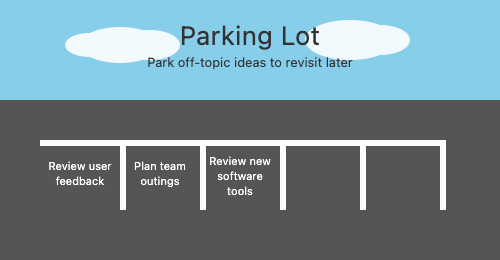As a project manager, the way you facilitate meetings shapes your team’s culture and effectiveness. Just like planning with a group, a successful meeting begins when everyone knows what to expect. The way you facilitate meetings shapes your team’s culture and effectiveness — leading with clarity, positivity, and inclusivity helps everyone feel valued and motivated to contribute.
In this lesson, you’ll learn how to:
- Set clear objectives so everyone knows the meeting’s purpose
- Keep meetings focused and respectful, even when challenges arise
- Actively encourage participation and value diverse perspectives
Clarity is the foundation of a productive meeting. When you state the meeting’s purpose up front, you help everyone understand what needs to be accomplished. For example, instead of a vague invite like, “Let’s discuss the project,” try, “By the end of this meeting, we’ll agree on the next sprint’s priorities and assign owners for each task.”
At the start of the meeting, restate your objectives so everyone is aligned. If the conversation drifts, gently guide it back: “Let’s park that topic for now so we can finish our sprint planning.” This is where the parking lot method comes in handy. You can create a visible list (on a whiteboard or shared document) for off-topic ideas or issues that come up and let the team know you’ll revisit these items at the end or after the meeting. This approach respects everyone’s time and keeps the group focused.

Your language and tone set the mood for the meeting. Tension is bound to arise when priorities clash or disagreements surface, but the way you communicate can shift the atmosphere from defensive to collaborative. By modeling a solution-oriented mindset, you can help resolve disagreements quickly and constructively. For example, if a deadline is missed, avoid blame and focus on learning: “Let’s look at what caused the delay and how we can prevent it next time.”
If you sense tension, acknowledge it and invite open dialogue: “I see there are strong opinions here, which shows everyone cares about the outcome. Let’s hear each perspective and find a way forward together.” This helps de-escalate conflict and encourages collaboration.
Here’s how this might sound in practice:
- Jessica: Thanks for joining, everyone. Our main goal today is to finalize the timeline for the dashboard release and assign owners for each task.
- Chris: I’m concerned about the QA timeline. Last time, we ran into delays because development wasn’t finished on schedule.
- Jessica: I appreciate you raising that, Chris. Let’s look at what caused the delay last time and see how we can adjust our plan to avoid it.
- Chris: I think we underestimated the integration work. If we can get earlier updates from engineering, QA can plan better.
- Jessica: That’s a great suggestion. Let’s add a mid-sprint check-in so everyone stays aligned. Does that work for the team?
Jessica sets a clear objective, responds to concerns with positivity, and invites collaborative problem-solving — focusing on solutions, not blame.
Inclusive meetings draw out ideas from everyone, not just the most vocal participants. As the facilitator, it’s important to actively encourage quieter team members to share their perspectives. This not only helps generate better ideas, but also builds trust and engagement across the team.
Before retrospectives or brainstorming sessions, set the tone for openness and psychological safety. For example: “All feedback is welcome — there are no bad ideas here. The more perspectives we have, the better our results.”
Here are some practical ways to encourage participation from everyone:
By using inclusive language and inviting input from all team members, you help ensure meetings are productive, respectful, and energizing for everyone.
By setting clear objectives, modeling positivity, and actively inviting participation, you’ll create meetings where everyone feels heard and motivated to contribute. As you move forward, try incorporating one new technique from this lesson into your next meeting — whether it’s using a parking lot, inviting quieter voices, or setting a clear agenda. Notice how these small changes can make your meetings more focused, inclusive, and productive. Next up: Practice applying these techniques by planning and facilitating a meeting scenario where you’ll set clear objectives, use the parking lot method, and encourage participation from every team member.
